2018 HONDA CLARITY FUEL CELL wheel
[x] Cancel search: wheelPage 6 of 551
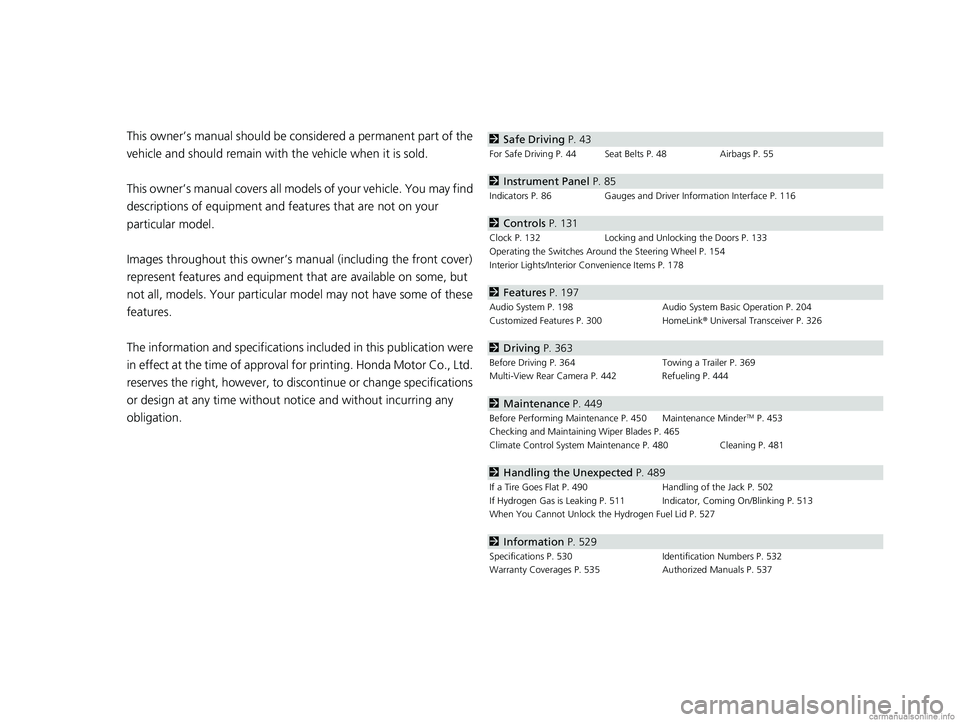
Contents
This owner’s manual should be considered a permanent part of the
vehicle and should remain with the vehicle when it is sold.
This owner’s manual covers all models of your vehicle. You may find
descriptions of equipment and features that are not on your
particular model.
Images throughout this owner’s manual (including the front cover)
represent features and equipment that are available on some, but
not all, models. Your particular mo del may not have some of these
features.
The information and specifications in cluded in this publication were
in effect at the time of approval for printing. Honda Motor Co., Ltd.
reserves the right, however, to discontinue or change specifications
or design at any time without notice and without incurring any
obligation.2 Safe Driving P. 43
For Safe Driving P. 44 Seat Belts P. 48 Airbags P. 55
2Instrument Panel P. 85
Indicators P. 86 Gauges and Driver Information Interface P. 116
2Controls P. 131
Clock P. 132 Locking and Unlocking the Doors P. 133
Operating the Switches Around the Steering Wheel P. 154
Interior Lights/Interior Convenience Items P. 178
2 Features P. 197
Audio System P. 198 Audio System Basic Operation P. 204
Customized Features P. 300 HomeLink® Universal Transceiver P. 326
2 Driving P. 363
Before Driving P. 364 Towing a Trailer P. 369
Multi-View Rear Camera P. 442 Refueling P. 444
2 Maintenance P. 449
Before Performing Maintenance P. 450 Maintenance MinderTM P. 453
Checking and Maintaining Wiper Blades P. 465
Climate Control System Main tenance P. 480 Cleaning P. 481
2Handling the Unexpected P. 489
If a Tire Goes Flat P. 490 Handling of the Jack P. 502
If Hydrogen Gas is Leaking P. 511 Indicator, Coming On/Blinking P. 513
When You Cannot Unlock the Hydrogen Fuel Lid P. 527
2 Information P. 529
Specifications P. 530 Identification Numbers P. 532
Warranty Coverages P. 535 Authorized Manuals P. 537
18 CLARITY FUEL CELL PPO-31TRT6100.book 4 ページ 2017年11月21日 火曜日 午後3時3分
Page 8 of 551
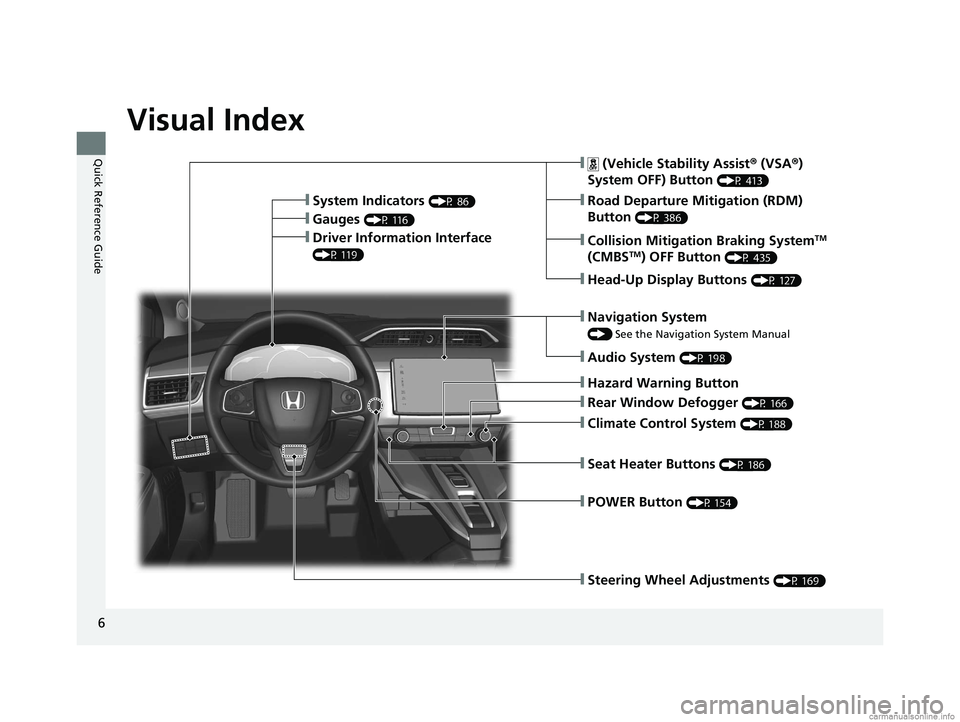
6
Quick Reference Guide
Quick Reference Guide
Visual Index
❙Steering Wheel Adjustments (P 169)
❙ (Vehicle Stability Assist® (VSA ®)
System OFF) Button
(P 413)
❙Road Departure Mitigation (RDM)
Button
(P 386)
❙System Indicators (P 86)
❙Gauges (P 116)
❙Collision Mitigation Braking SystemTM
(CMBSTM) OFF Button (P 435)
❙Head-Up Display Buttons (P 127)
❙Driver Information Interface
(P 119)
❙Navigation System
() See the Navigation System Manual
❙Audio System (P 198)
❙Hazard Warning Button
❙Climate Control System (P 188)
❙Rear Window Defogger (P 166)
❙POWER Button (P 154)
❙Seat Heater Buttons (P 186)
18 CLARITY FUEL CELL PPO-31TRT6100.book 6 ページ 2017年11月21日 火曜日 午後3時3分
Page 23 of 551
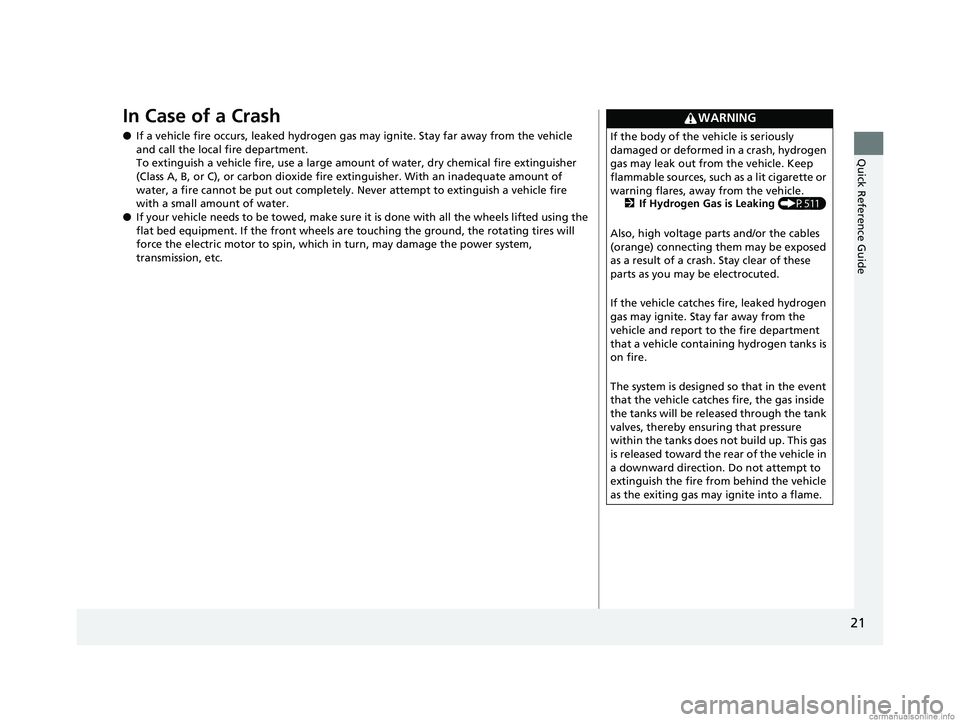
21
Quick Reference Guide
In Case of a Crash
●If a vehicle fire occurs, leaked hydrogen gas may ignite. Stay far away from the vehicle
and call the local fire department.
To extinguish a vehicle fire, use a large amount of water, dry chemical fire extinguisher
(Class A, B, or C), or carbon dioxide fire extinguisher. With an inadequate amount of
water, a fire cannot be put out completely. Never attempt to extinguish a vehicle fire
with a small amount of water.
● If your vehicle needs to be towed, make sure it is done with all the wheels lifted using the
flat bed equipment. If the front wheels are touching the ground, the rotating tires will
force the electric motor to spin, which in turn, may damage the power system,
transmission, etc.
WARNING
If the body of the vehicle is seriously
damaged or deformed in a crash, hydrogen
gas may leak out from the vehicle. Keep
flammable sources, such as a lit cigarette or
warning flares, away from the vehicle. 2If Hydrogen Gas is Leaking (P511)
Also, high voltage parts and/or the cables
(orange) connecting them may be exposed
as a result of a crash. Stay clear of these
parts as you may be electrocuted.
If the vehicle catches fire, leaked hydrogen
gas may ignite. Stay far away from the
vehicle and report to the fire department
that a vehicle containing hydrogen tanks is
on fire.
The system is designed so that in the event
that the vehicle catches fire, the gas inside
the tanks will be released through the tank
valves, thereby ensuring that pressure
within the tanks does not build up. This gas
is released toward the rear of the vehicle in
a downward direction. Do not attempt to
extinguish the fire from behind the vehicle
as the exiting gas may ignite into a flame.
18 CLARITY FUEL CELL PPO-31TRT6100.book 21 ページ 2017年11月21日 火曜日 午後3時3分
Page 27 of 551
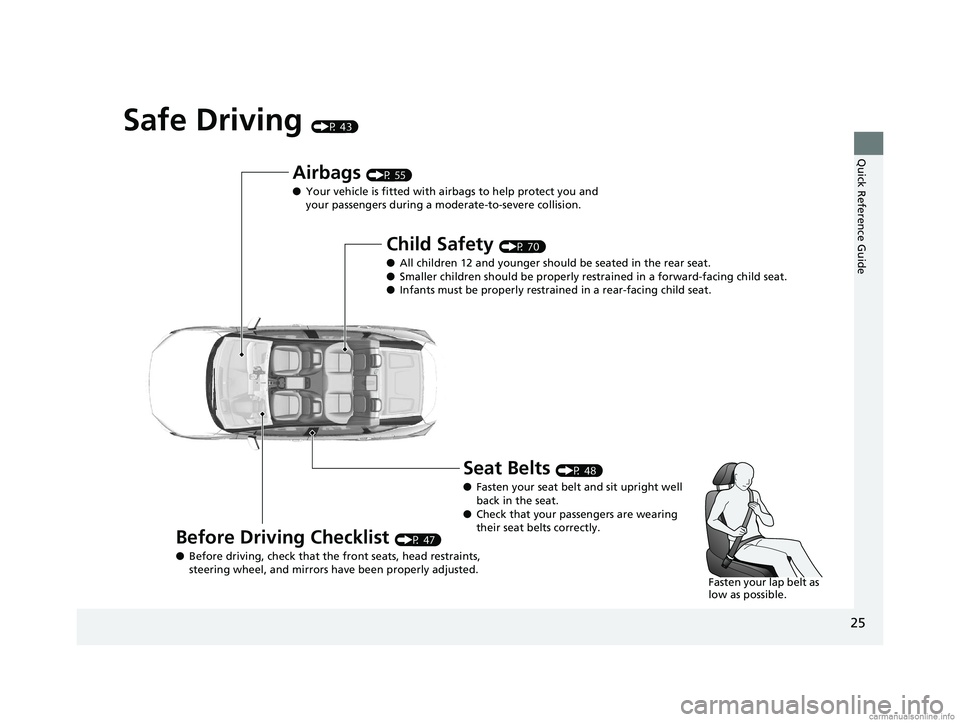
25
Quick Reference Guide
Safe Driving (P 43)
Airbags (P 55)
● Your vehicle is fitted with ai rbags to help protect you and
your passengers during a moderate-to-severe collision.
Child Safety (P 70)
● All children 12 and younger should be seated in the rear seat.
● Smaller children should be properly restra ined in a forward-facing child seat.
● Infants must be properly restraine d in a rear-facing child seat.
Before Driving Checklist (P 47)
● Before driving, check that the front seats, head restraints,
steering wheel, and mirrors have been properly adjusted.
Seat Belts (P 48)
● Fasten your seat belt and sit upright well
back in the seat.
● Check that your passengers are wearing
their seat belts correctly.
Fasten your lap belt as
low as possible.
18 CLARITY FUEL CELL PPO-31TRT6100.book 25 ページ 2017年11月21日 火曜日 午後3時3分
Page 30 of 551
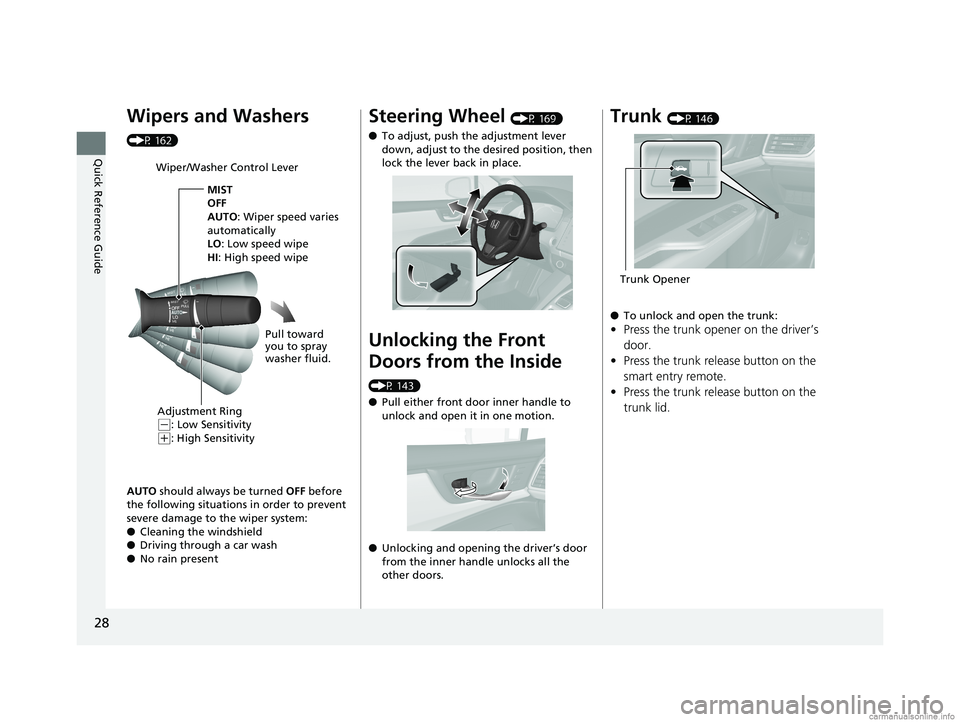
28
Quick Reference Guide
Wipers and Washers
(P 162)
AUTO should always be turned OFF before
the following situations in order to prevent
severe damage to the wiper system:
● Cleaning the windshield
● Driving through a car wash
● No rain present
Wiper/Washer Control Lever
Adjustment Ring
(-: Low Sensitivity
(+: High Sensitivity MIST
OFF
AUTO
: Wiper speed varies
automatically
LO: Low speed wipe
HI: High speed wipe
Pull toward
you to spray
washer fluid.
Steering Wheel (P 169)
● To adjust, push the adjustment lever
down, adjust to the desired position, then
lock the lever back in place.
Unlocking the Front
Doors from the Inside
(P 143)
●Pull either front door inner handle to
unlock and open it in one motion.
● Unlocking and opening the driver’s door
from the inner handle unlocks all the
other doors.
Trunk (P 146)
● To unlock and open the trunk:
•Press the trunk opener on the driver’s
door.
• Press the trunk release button on the
smart entry remote.
• Press the trunk release button on the
trunk lid.
Trunk Opener
18 CLARITY FUEL CELL PPO-31TRT6100.book 28 ページ 2017年11月21日 火曜日 午後3時3分
Page 39 of 551
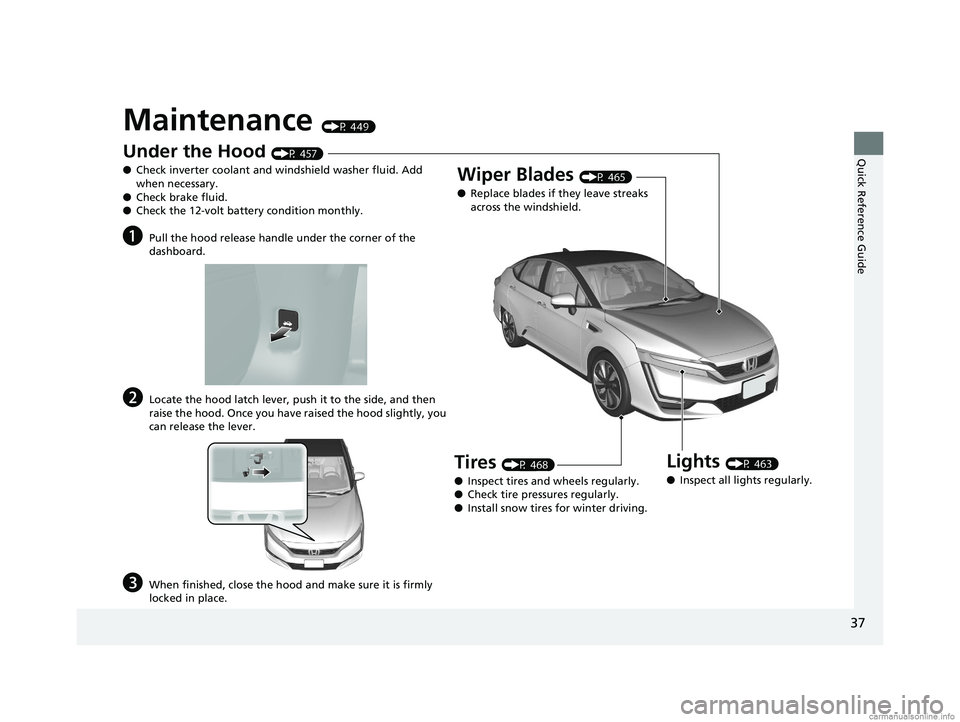
37
Quick Reference Guide
Maintenance (P 449)
Under the Hood (P 457)
● Check inverter coolant and windshield washer fluid. Add
when necessary.
● Check brake fluid.
● Check the 12-volt battery condition monthly.
aPull the hood release handle under the corner of the
dashboard.
bLocate the hood latch lever, push it to the side, and then
raise the hood. Once you have raised the hood slightly, you
can release the lever.
cWhen finished, close the hood and make sure it is firmly
locked in place.
Lights (P 463)
● Inspect all lights regularly.
Wiper Blades (P 465)
● Replace blades if they leave streaks
across the windshield.
Tires (P 468)
● Inspect tires and wheels regularly.
● Check tire pressures regularly.
● Install snow tires for winter driving.
18 CLARITY FUEL CELL PPO-31TRT6100.book 37 ページ 2017年11月21日 火曜日 午後3時3分
Page 58 of 551

56
uuAirbags uAirbag System Components
Safe Driving
The front, driver’s knee, front side, and side
curtain airbags are deployed according to
the direction and severity of impact. Both
side curtain airbags are deployed in a
rollover. The airbag system includes:
aTwo SRS (Supplemental Restraint System)
front airbags. The driver’s airbag is stored
in the center of the steering wheel; the
front passenger’s airbag is stored in the
dashboard. Both are marked SRS
AIRBAG.
bDriver’s knee airbag. The knee airbag is
stored under the steering column. It is
marked SRS AIRBAG.
cTwo side airbags, one for the driver and
one for a front passenger. The airbags are
stored in the outer edges of the seat-
backs. Both are marked SIDE AIRBAG .
dTwo side curtain airbags, one for each
side of the vehicle. The airbags are stored
in the ceiling, above the side windows.
The front and rear pillars are marked
SIDE CURTAIN AIRBAG.
eAn electronic control unit that, when the
vehicle is on, continually monitors
information about the various impact
sensors, seat and buckle sensors, rollover
sensor, airbag activators, seat belt
tensioners, seat weight sensor, seat
position sensor, passenger airbag OFF
indicator, and other vehicle information.
During a crash event the unit can record
such information.
fAutomatic front seat belt tensioners. In
addition, the driver’s and front
passenger’s seat belt buckles incorporate
sensors that detect whether or not the
belts are fastened.
gA driver’s seat position sensor. This
sensor determines the optimal force at
which the airbag will deploy in a crash.
hWeight sensors in the front passenger’s
seat. The front passenger’s airbag will be
turned off if the weight on the seat is
approximately 65 lbs (29 kg) or less (the
weight of an infant or small child).
iImpact sensors that can detect a
moderate-to-severe front or side impact.
jAn indicator on the dashboard that alerts
you that the front passenger’s front
airbag has been turned off.
kAn indicator on the instrument panel that
alerts you to a possibl e problem with your
airbag system or seat belt tensioners.
lA rollover sensor that can detect if your
vehicle is about to roll over and signal the
control unit to deploy both side curtain
airbags.
18 CLARITY FUEL CELL PPO-31TRT6100.book 56 ページ 2017年11月21日 火曜日 午後3時3分
Page 59 of 551
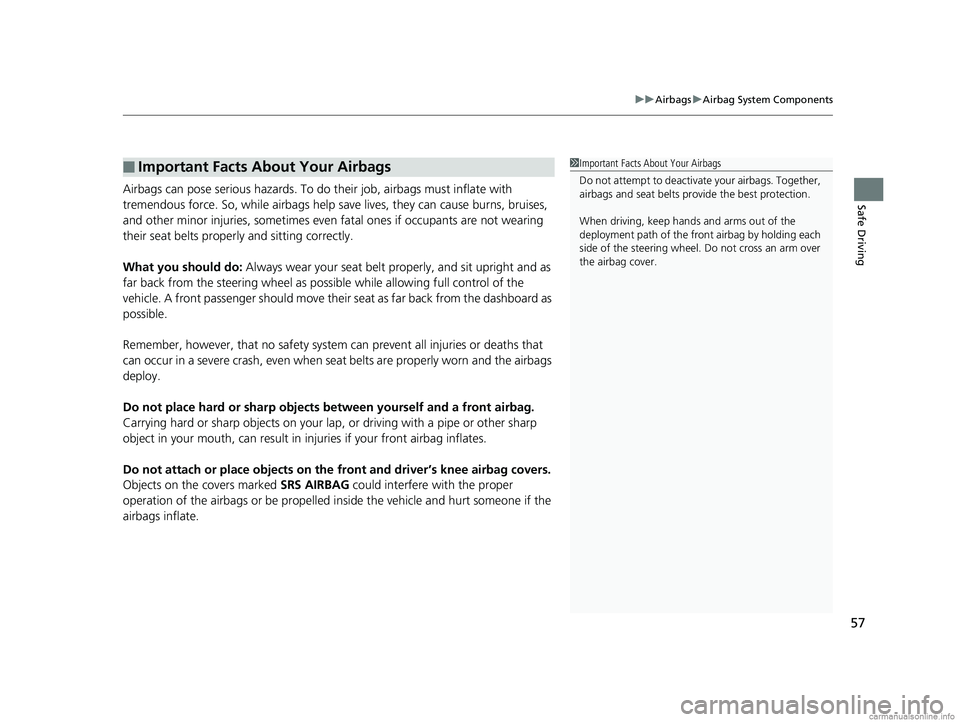
57
uuAirbags uAirbag System Components
Safe DrivingAirbags can pose serious hazards. To do their job, airbags must inflate with
tremendous force. So, while airbags help sa ve lives, they can cause burns, bruises,
and other minor injuries, sometimes even fatal ones if occupants are not wearing
their seat belts properl y and sitting correctly.
What you should do: Always wear your seat belt properly, and sit upright and as
far back from the steering wheel as possi ble while allowing full control of the
vehicle. A front passenger should move their seat as far back from the dashboard as
possible.
Remember, however, that no safety system ca n prevent all injuries or deaths that
can occur in a severe crash, even when s eat belts are properly worn and the airbags
deploy.
Do not place hard or sharp objects between yourself and a front airbag.
Carrying hard or sharp objects on your lap, or driving with a pipe or other sharp
object in your mouth, can result in in juries if your front airbag inflates.
Do not attach or place objects on the front and driver’s knee airbag covers.
Objects on the covers marked SRS AIRBAG could interfere with the proper
operation of the airbags or be propelled inside the vehicle and hurt someone if the
airbags inflate.
■Important Facts About Your Airbags1 Important Facts About Your Airbags
Do not attempt to deactivate your airbags. Together,
airbags and seat belts pr ovide the best protection.
When driving, keep hand s and arms out of the
deployment path of the front airbag by holding each
side of the steering wheel. Do not cross an arm over
the airbag cover.
18 CLARITY FUEL CELL PPO-31TRT6100.book 57 ページ 2017年11月21日 火曜日 午後3時3分